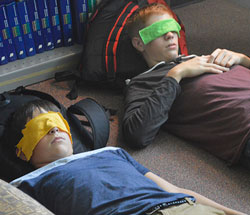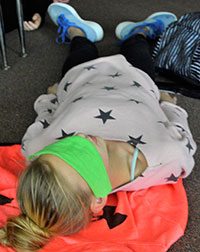Twenty-eight students lie on the floor of a darkened classroom, cloth masks over their eyes, silently listening to the soothing murmur of ocean waves and cries of seagulls. At the end of a hard day of studying, their minds are being taken somewhere far away.
“Allow yourself to lay down on the sand,” says a voice with a soft Australian accent. “Above you, you can see fluffy white clouds against a beautiful blue sky. Your thoughts disappear, replaced by this music of nature.”

Sound like a meditation session? It really is, but inside the busy hallways of Kenowa Middle School. Here, in teacher Lisa White’s classroom, students come once a week to rest, relax and even fall asleep, lulled by the guided meditations White plays for them while the fragrance of essential oils fills the air.
“Here, you are content to just be,” the voice says. “You know that all your cares are far behind you – a tiny pile of pebbles washed away by the sea.”
The class is called mindfulness/meditation, one of a couple dozen “choice rooms” the school is providing at the end of each school day. Students who are on track with their studies can choose anything from chess, Minecraft and gym sports to computer coding, poetry and school newspaper.
A different menu each day also includes activities like Student Council and school beautification projects. Meanwhile, students who need to catch up academically work with tutors.


Helping, Motivating and Rewarding
The half-hour period was implemented this fall as a way to help struggling students, give them incentive to improve and offer creative outlets for students on pace in their classes, says Principal Abby Wiseman.
“We want to get away from being punitive, and we want to reward students who are on pace and motivate those who need some extra help,” Wiseman says.
The setup complements the district’s emphasis on personal mastery, where students move ahead in their subjects at different rates, by building in extra time for those who need it to meet standards. Last year, on-track students felt punished by being sent to large study rooms while others received tutoring, Wiseman says.
Teachers submitted ideas for choice rooms, and students will be invited to submit their own ideas for second semester. Attendance is first-come, first-serve.
A majority of the school’s 720 students attend the choice rooms, which provide experiences beyond the usual school schedule. That benefits student performance, attendance and school community, Wiseman says.
“There’s a huge correlation between a kid feeling a sense of belonging and being a part of something outside of what school offers every single day,” she adds.

Benefits Carry Over
Mindfulness meditation has proven one of the more popular offerings. Attendance had to be capped at 30 when 35 to 40 students started coming, over-filling White’s sixth-grade classroom.
She proposed the class based on her own positive experience with meditation.
“I thought, what would I love to be able to do during the day?” White said. “Stop and meditate.”
She’s seen how meditation calms fidgety and stressed students, and how it can be an aid to classroom teaching.
She tells of one student who started getting anxious at a cross-country meet, but calmed himself with techniques he’d learned in the meditation period. Other students have taken to meditating at home.
“I feel the calm they bring to the classroom carries over,” she says, adding she would like to see meditation used to help with behavior problems and reduce testing stress. She and fellow teacher Shannon Goebel have applied for a grant to become certified mindfulness instructors, and hope to help integrate it into the eighth-grade health curriculum.
Sixth-grader Jennifer Dyke has come to almost all the sessions.
“It makes me feel more awake,” Jennifer says after a recent meditation. “It feels like you went to sleep, you woke up, and you’re not tired.”
“It feels good,” agrees sixth-grader Reese Walski. “It calms my body and relaxes me.”
The good feeling continues after school, adds seventh-grader Kaitlin Dykstra: “I’ll be more relaxed, and not get in fights with my brother.”
CONNECT
Mindful Schools: Meditation Techniques for Teachers
Jason Stephenson’s Empowering Meditations









